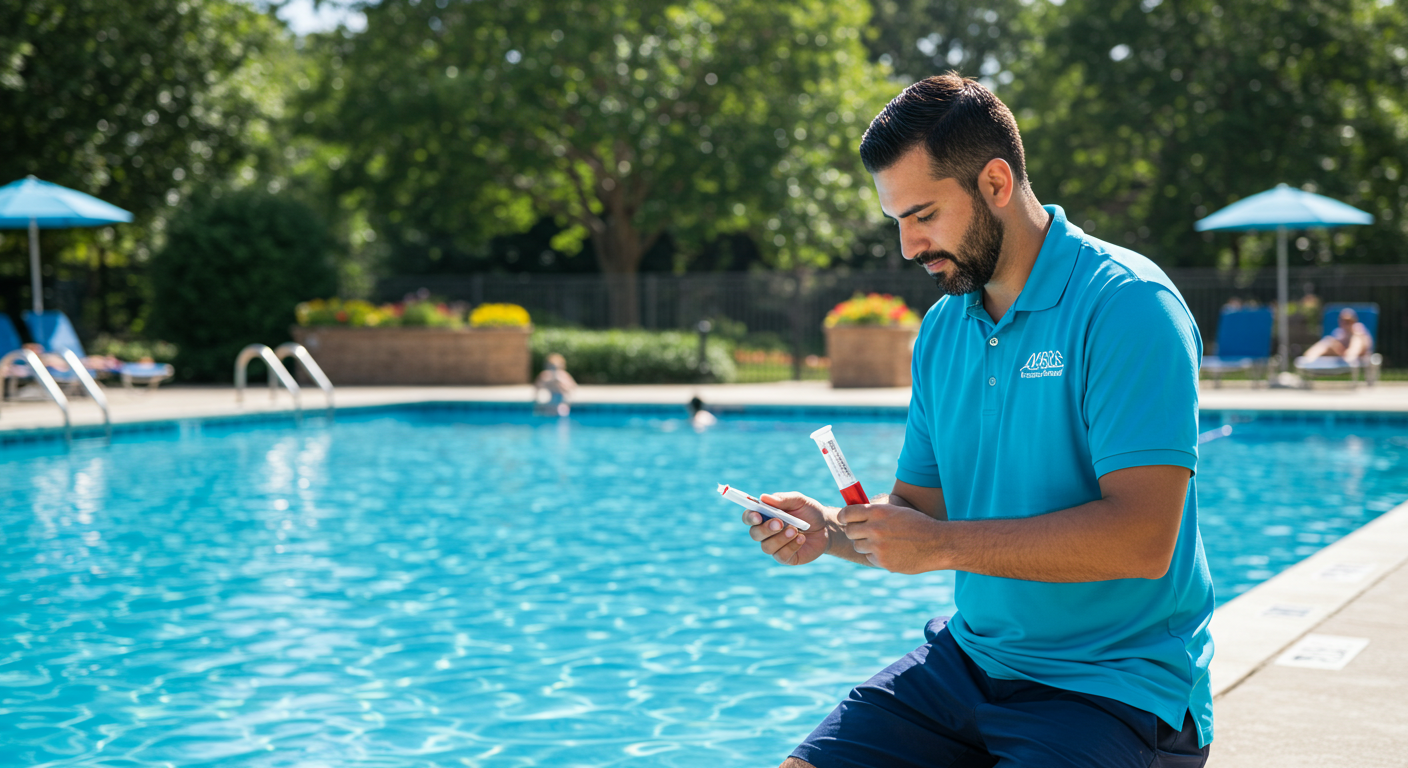How to Lower Alkalinity in Pool Water
How to Lower Alkalinity in Pool Water: Complete Guide
Taking care of your pool’s total alkalinity is essential for keeping the water safe, clean, and comfortable for everyone. Alkalinity helps keep the pH level stable, which is key for having clean water and a good swimming experience. If your pool has high alkalinity, don’t worry! This guide will help you fix the problem and keep your pool in great shape. This is a key part of regular pool maintenance service.
Why Pool Alkalinity Matters
Total alkalinity is an important part of your pool’s chemistry. It helps stop the pH levels from changing too much, keeping the water balanced. If your pool’s alkalinity is too high or too low, it can cause problems with the water’s cleanliness and comfort.

What Is Total Alkalinity in a Pool?
Total alkalinity is the measure of things in your pool water, like bicarbonate, carbonate, and hydroxide ions, which help stop the pH from changing quickly. The ideal range for alkalinity in a pool is between 100–150 ppm (parts per million). If it’s higher or lower, you could have problems like cloudy water, scaling, or reduced chlorine efficiency. Maintaining proper alkalinity is one of the key goals of a quality pool service.
Alkalinity vs. pH: Key Differences Explained
Alkalinity is about how stable your pH is. pH shows if the water is acidic (low pH) or basic (high pH). If alkalinity is too high, it can make the pH go up, causing issues like cloudy water and problems with chlorine. If the alkalinity is too low, the pH can change quickly, leading to instability.
How Alkalinity and pH Affect Each Other
If your pool’s alkalinity is too high, the pH will also go up. This makes the water too basic, which can lead to skin irritation and make chlorine less effective. Keeping the right balance between alkalinity and pH is crucial for a clean and comfortable pool, and it’s something every professional pool maintenance service monitors regularly.
What Causes High Alkalinity in Pool Water?
High alkalinity can be caused by many things, including the chemicals you use to maintain the pool.
Common Causes of Elevated Total Alkalinity
Some things that can increase your pool’s alkalinity include:
- Using sodium bicarbonate (baking soda), which increases alkalinity.
- Using chlorine products like trichloroisocyanuric acid (Trichlor), which are often too strong for pools with already high alkalinity.
- Calcium carbonate in the water, which comes from carbonate rocks or high calcium levels.
- Using too many chemicals or using chemicals incorrectly. For example, adding too much soda ash or calcium hardness increasers can push alkalinity above the desired range.
Effects of Cyanuric Acid on Alkalinity
Cyanuric acid (CYA) is used to stabilize chlorine, but if there’s too much, it can also increase alkalinity. This can make balancing your pool’s water even harder. It’s important to test for CYA and adjust levels accordingly to avoid the effects of high alkalinity. Proper chemical management is always part of a well-planned pool maintenance service.
Low Sanitizer Levels and Their Role
Low levels of chlorine or other pool sanitizers can lead to high carbon dioxide in the water. This can raise the alkalinity, making the water harder to balance. A good sanitizer level helps maintain the water’s balance and reduces the chances of unwanted chemical reactions.
Pool Shock and Alkalinity Spikes
Pool shock (like calcium hypochlorite) can raise alkalinity if it’s not used correctly. Overuse of pool shock can also cause calcium deposits on the pool’s surface, making the water cloudy and the pool harder to clean. Always use pool shock carefully and follow the instructions for the right amount.
What Happens if Pool Alkalinity Is Too High?
High alkalinity can cause several problems in your pool, including water quality issues and swimmer discomfort.
Increased pH Levels
High alkalinity often makes the pH level go up. This makes the water too basic, which can lead to skin and eye irritation for swimmers. A high pH can also make pool equipment wear out faster.
Reduced Chlorine Efficiency
When the pH is high because of high alkalinity, the chlorine in the pool doesn’t work as well. This can make the water unsafe, allowing bacteria and algae to grow. Lowering alkalinity restores the chlorine’s ability to sanitize the water, keeping it safe for swimming. This is a key part of a professional pool service plan.
Skin and Eye Irritation
When the pH is too high, it can make the water uncomfortable. It can cause eye irritation and skin dryness, which can be annoying for swimmers. If swimmers report discomfort, it could be a sign that the alkalinity needs to be corrected.
Scale Formation on Pool Surfaces
High alkalinity can cause calcium scaling on the walls, floors, and tiles of your pool. These hard calcium deposits can make your pool look dirty and clog up your filters. Scale buildup is tough to remove and can lead to expensive repairs if not addressed early.
Cloudy or Murky Water
If the alkalinity is too high, it can cause the water to look cloudy. This is a sign that something is wrong with the water chemistry. Fixing alkalinity can help clear up the water, making it more inviting for swimmers.
How to Lower Alkalinity in Pool Effectively
To fix high alkalinity, follow these steps to get your pool water back in balance.
Step-by-Step Guide to Lowering Alkalinity
- Test Your Pool Water: Use a test kit or test strips to check the total alkalinity and pH levels. Testing often ensures that you’re adding the right amount of chemicals.
- Add Muriatic Acid: Muriatic acid (also called hydrochloric acid) is often used to lower alkalinity. Add it slowly to your pool while the pump is running to mix it well. Avoid adding large amounts at once.
- Use Sodium Bisulfate: You can also use sodium bisulfate (also called dry acid) to lower alkalinity safely. It’s easier to handle than muriatic acid.
- Aeration: In some cases, you can use aeration (letting air into the water) to help lower carbon dioxide levels and reduce alkalinity naturally. It’s a slower process but can be effective for slight adjustments.
How to Use Muriatic Acid Safely
When using muriatic acid, make sure to wear gloves and goggles. Add the acid in small amounts and let the water mix before checking the alkalinity again. Always read the instructions and safety labels to prevent accidents.
Using Sodium Bisulfate to Reduce Alkalinity
Sodium bisulfate (dry acid) is a safer option than muriatic acid. It can lower alkalinity without affecting the pH too much. Follow the instructions on the package for the right amount to use. It’s a good alternative if you want more control over how quickly the alkalinity changes.
Best Practices for Accurate Testing
Regular testing is key to maintaining balanced water. Use a test kit or test strips to check alkalinity and pH at least once a week. If you’ve recently added chemicals, wait 24–48 hours before retesting to get accurate results. This is standard in any good pool maintenance service.
How to Lower Alkalinity in Pool Without Affecting pH
If you need to lower alkalinity but not affect the pH, you can:
- Add muriatic acid very slowly and keep checking the pH to make sure it doesn’t go too low.
- Use aeration to lower carbon dioxide and adjust alkalinity without changing pH too much. This method can take longer, but it’s safe for slight adjustments.
How to Maintain Balanced Alkalinity After Correction
After lowering alkalinity, you need to keep it balanced. Here’s how to maintain it:
Recommended Ranges for Total Alkalinity
Keep alkalinity between 100–150 ppm. If it’s lower than 100 ppm, it can make the pH unstable, leading to poor water balance. If it’s higher than 150 ppm, you can get scaling and cloudy water.
Regular Testing and Monitoring Tips
Test your pool water often using a test kit or test strips. Use an automatic pool monitoring system to make testing easier and more accurate. Systems like WaterGuru SENSE provide real-time data, which helps you stay on top of your pool’s chemistry.
Preventing Future Imbalances
Regularly check the alkalinity and pH. Keep an eye on things like the number of swimmers and the weather, since these can affect the pool’s chemical balance. Also, make sure the pool filtration system is running smoothly. These are standard tasks included in any thorough pool service.
Advanced Tips: How to Lower Alkalinity in Pool Using Automation
There are systems that can help you keep your pool’s chemistry balanced automatically. These smart systems can adjust the chemicals for you and make pool maintenance service easier.
The Role of Smart Pool Monitoring Systems
Devices like optical sensors can check the pool’s water and adjust things like alkalinity and pH automatically, so you don’t have to do it manually. This is especially useful for busy pool owners who want to save time and ensure their pool is always in perfect balance.
Advantages of Automated Dosing and Feedback Control
Automated systems add the right amount of chemicals at the right time. They help keep your pool in balance without you having to do it yourself. This reduces the chances of human error and ensures a healthier pool.
Frequently Asked Questions About How to Lower Alkalinity in Pool
How Fast Can You Lower Pool Alkalinity?
It can take up to 48 hours to lower alkalinity. Always check the levels before adding more chemicals. If you’re using muriatic acid or sodium bisulfate, allow time for the chemicals to mix and stabilize.
What Happens if You Ignore High Alkalinity?
If you don’t fix high alkalinity, the water will become cloudy, and scaling can form. It will also reduce the effectiveness of chlorine, making the water unsafe for swimming.
Can You Lower Alkalinity Without Affecting pH?
Yes, you can lower alkalinity without affecting pH by adding muriatic acid carefully or using aeration.
How to Correct Low Alkalinity if Over-Corrected
If you lower alkalinity too much, you can use sodium bicarbonate or baking soda to bring it back up to the right level. Be sure to test the water after making adjustments to prevent the issue from reoccurring.
Conclusion
Keeping your pool’s alkalinity in check is important for having clean, safe water and a good swimming experience. Regular testing, using the right chemicals, and possibly using automatic systems will make pool maintenance service easier and more effective. With the right care, you can enjoy clear and balanced water all season long. For lasting results, consider hiring a reliable pool service to help manage your water chemistry professionally.
